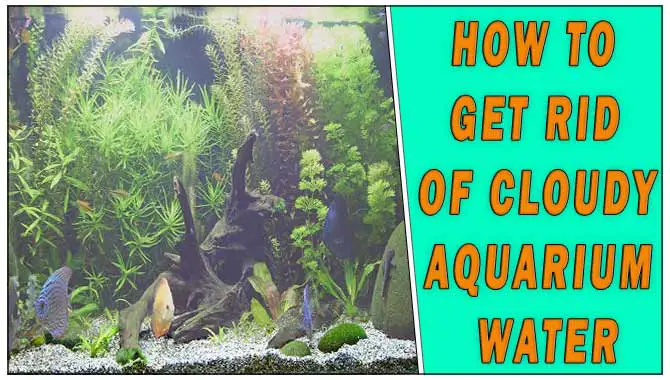Black algae, a common nuisance in fish tanks, form stubborn dark patches on various surfaces. This type of algae is notoriously challenging to control and remove. It thrives in stagnant water with high phosphate levels. Proper identification is essential for effective treatment.
When combating this menace, understanding its growth and behaviour is crucial. Here we will discuss the essential techniques for eliminating black algae in aquariums, from identifying the causes and indicators of black algae growth to steps for removing the algae, such as physical removal, hydrogen peroxide treatment, CO2 regulation, and heat treatments.
We will also cover incorporating algae eaters in your aquarium and maintaining water quality to prevent future outbreaks. We will answer one question that must be on your mind – is black algae harmful to my fish? Read on to learn about tackling this pesky problem in your aquarium.
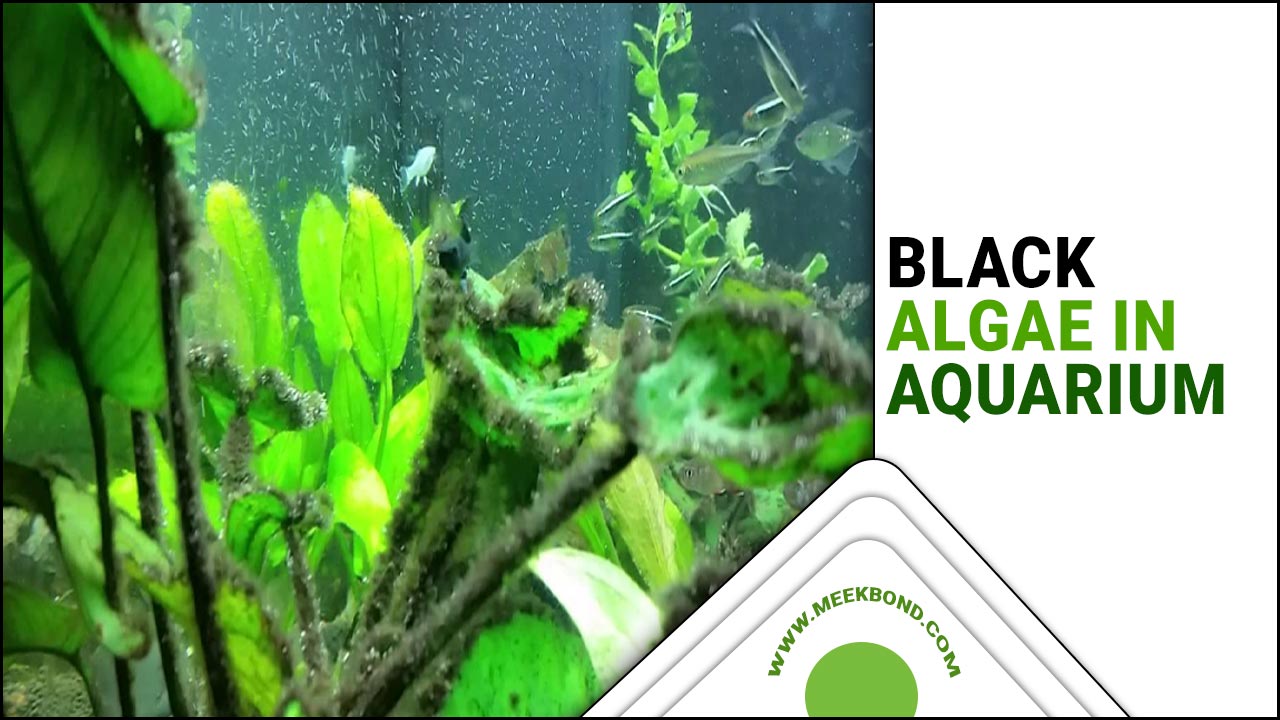
What Causes Black Beard Algae?
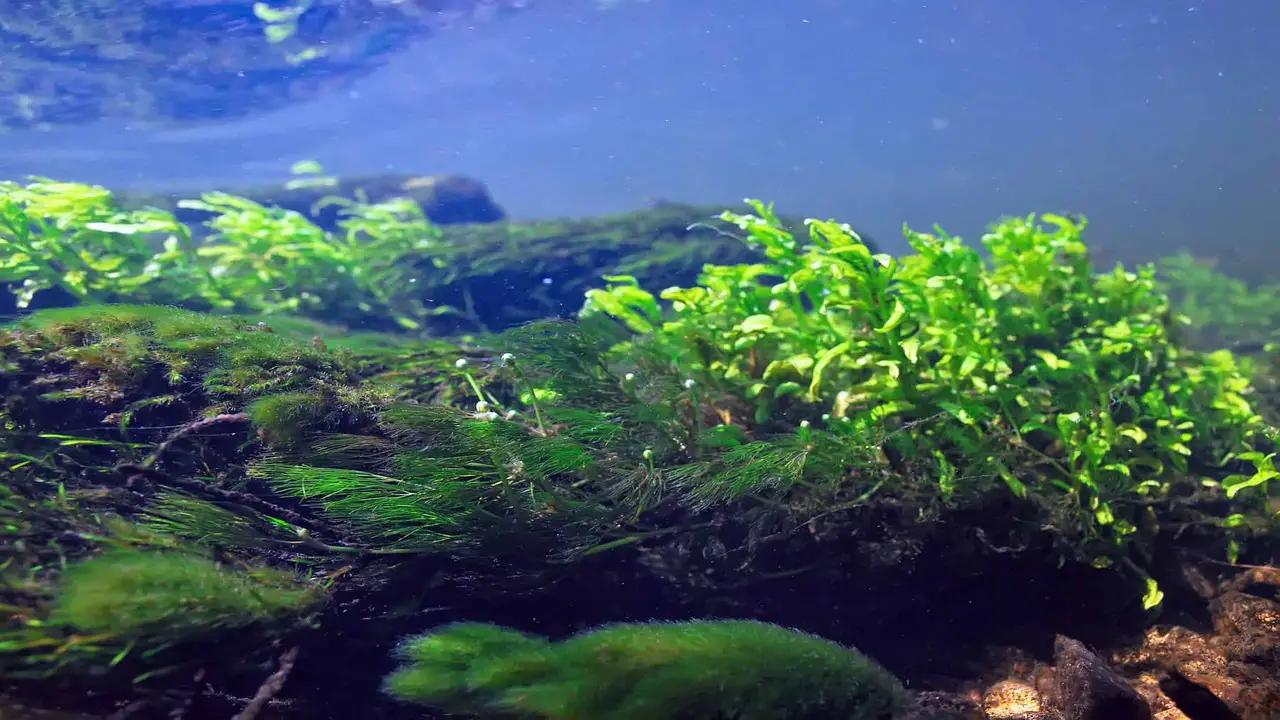
Black Algae Aquarium, also known as black brush algae (BBA), is a common problem in aquariums that arises due to nutrient imbalances and environmental conditions. High levels of phosphate, inadequate carbon dioxide, excessive light exposure, and spore introduction are some factors that contribute to the growth of black beard algae. This algae can quickly spread throughout an aquarium if left unchecked and can be difficult to eradicate once established.
How To Permanently Get Rid Of Black Algae In Aquarium?
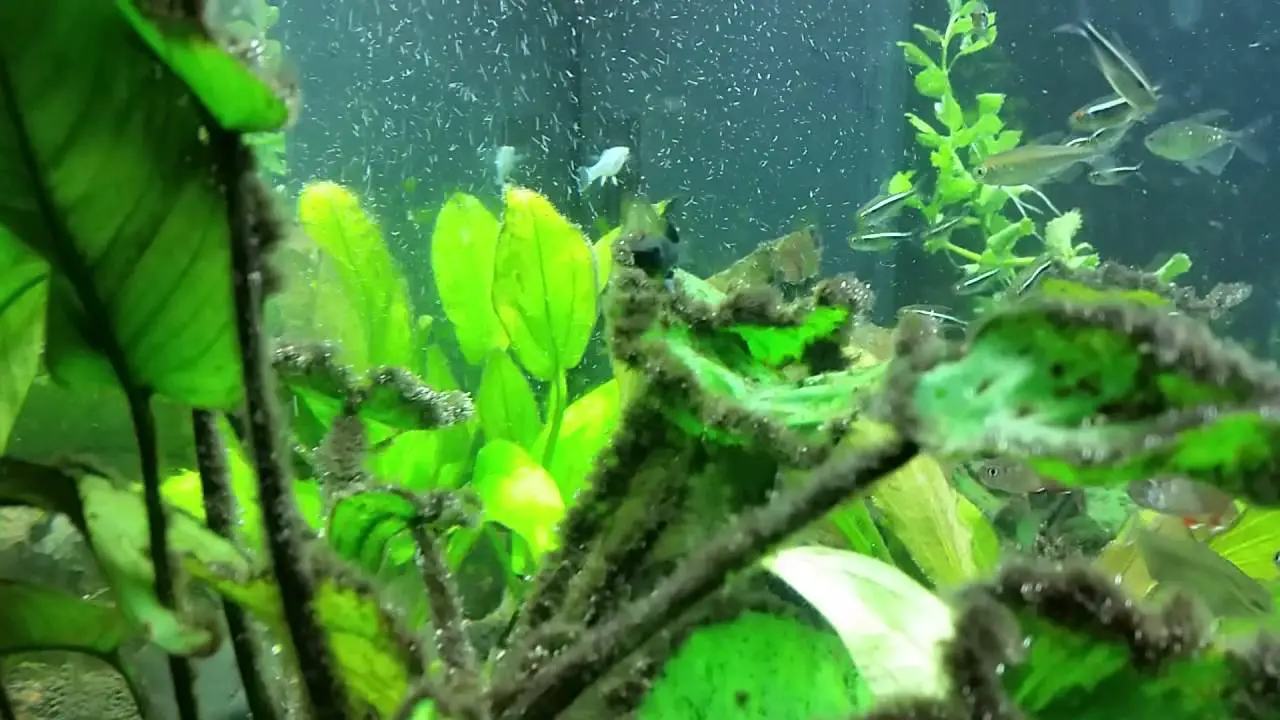
Regular aquarium maintenance, cleaning, and reducing light and nutrient levels can discourage black algae growth. Treating the existing black algae using hydrogen peroxide or specialized algae treatments can help eliminate it. Additionally, introducing natural predators like snails or shrimp can eat any remaining black algae. Here is the full process of How to Permanently Get Rid of Black Algae in Aquarium.
Remove Affected Decor And Plants With Hydrogen Peroxide
Removing affected decor and plants using hydrogen peroxide is crucial to combat black algae in your aquarium. This method helps eliminate the algae without harming your fish, live plants, or other aquatic species. Start by identifying any decorations or plants heavily infested with black algae. Carefully remove them from your fish tank and place them in a separate container. Mix a solution of hydrogen peroxide and water, ensuring a 1-part hydrogen peroxide ratio to 3 parts water.
Reduce Phosphate Levels In The Water
Reducing phosphate levels in the water is crucial to prevent black algae growth in your aquarium. One way to achieve this is by using phosphate removers, which effectively lower phosphate levels and inhibit algae growth. Regularly checking and maintaining proper water parameters can help prevent high phosphate levels. It’s important to limit the use of phosphate-rich fertilizers or additives, as they can contribute to elevated phosphate levels.
Increase Carbon Dioxide Levels
To increase carbon dioxide levels in your aquarium, you can consider installing a CO2 injection system or using liquid carbon supplements. These methods provide additional carbon dioxide essential for live plants’ growth. To distribute the carbon dioxide evenly, it is important to ensure proper circulation and aeration in the tank. Monitor and adjust the carbon dioxide levels based on the needs of your aquarium plants, as different species may require varying amounts.
Introduce Black Algae Eating Fish
Siamese algae eaters, Amano shrimp, and Nerite snails effectively control black beard algae in fish tanks. These algae-eating organisms can help keep the black algae in check and prevent its growth. Other fish, such as plecos or otocinclus catfish, can also be considered as they consume algae.
However, ensuring compatibility with existing fish and providing a proper tank size for the chosen species is important. Introducing these black algae-eating fish into the aquarium can help maintain a healthy and balanced ecosystem while keeping the stubborn algae at bay.
Boil Away The Algae With Heat Treatment
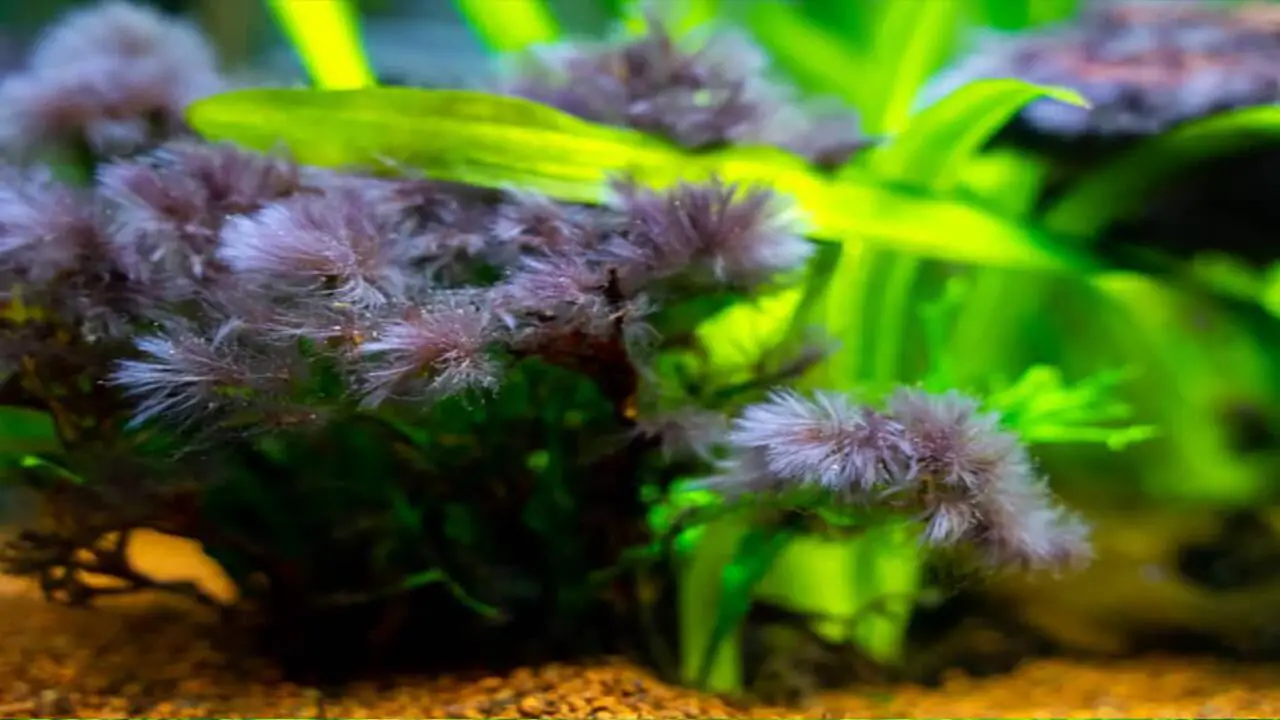
To effectively deal with black beard algae in your aquarium, one of the best ways is to use heat treatment. Start by manually removing the algae using a clean toothbrush or scrubber. Then, soak affected decorations or equipment in hot water, ensuring a temperature that can kill the algae but not harm the fish or beneficial bacteria. It’s important to be cautious when applying heat to the aquarium, as it can have detrimental effects. After the heat treatment, thoroughly rinse all items to remove any remaining algae spores.
Prevent Photosynthesis Of The Algae
You can implement several effective strategies to prevent the photosynthesis of black beard algae in your aquarium. Reduce the duration of light exposure in the tank. Use a timer to ensure consistent and appropriate lighting periods for your fish tank. This will help limit the amount of light available for the algae to perform photosynthesis.
Replace Contaminated Surfaces
Consider replacing any surfaces that are persistently affected by black beard algae. It is important to thoroughly clean and disinfect any new decorations or equipment before adding them to the fish tank to prevent the introduction of black beard algae. Additionally, be cautious when adding new fish or plants to the aquarium. Quarantine them first to ensure they are free from black beard algae infestation.
Reduce Light In The Tank
Reducing the amount of light is crucial to combat black algae in your aquarium. There are several ways to achieve this. Firstly, you can use light-blocking materials or covers to reduce the overall intensity of light in the tank. Additionally, adjusting the position or angle of your aquarium lights can minimize direct exposure to the affected areas. Consider using lower-wattage bulbs or LED lights with adjustable settings for better control over lighting.
Impacts Of Black Algae On Aquarium Health
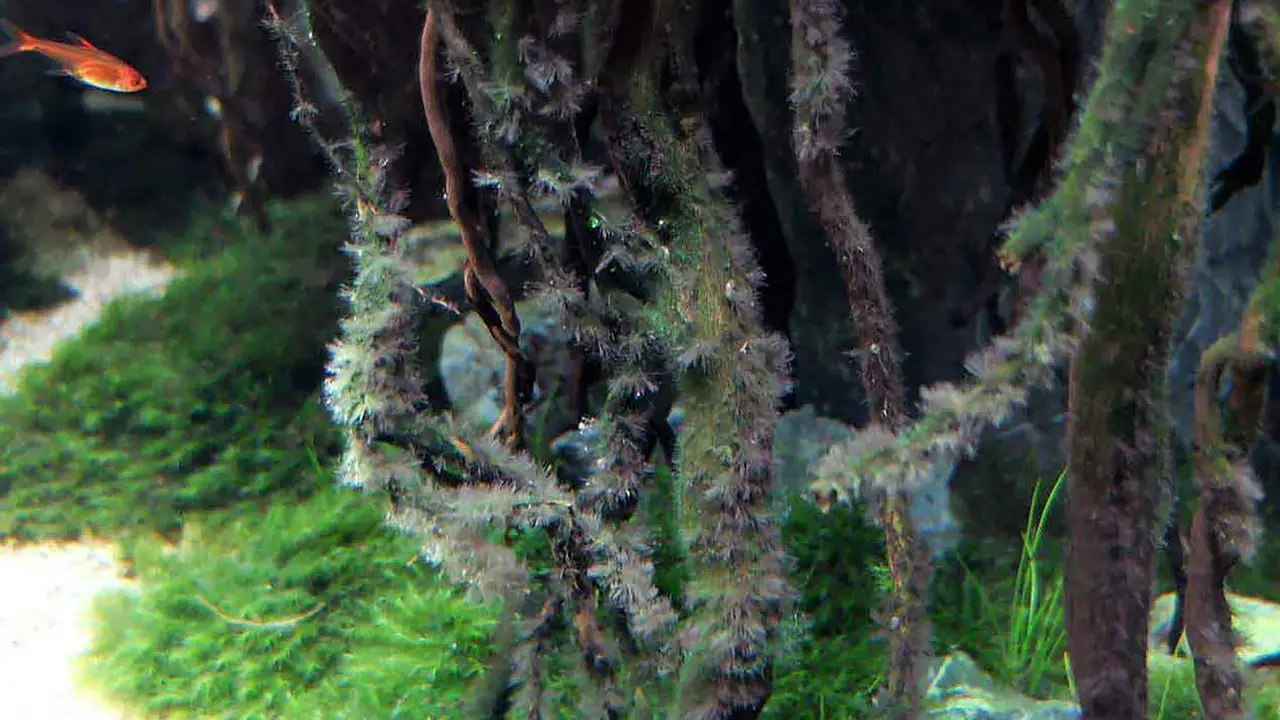
Black algae in an aquarium can harm the health of fish and other aquatic creatures. It can harm these organisms and lead to decreased oxygen and increased carbon dioxide levels in the water, further compromising their health. To prevent black algae outbreaks, it is important to keep the aquarium clean and well-maintained, avoid overfeeding, and ensure proper lighting and filtration systems.
If black algae do appear, various control methods can be used, such as removing affected plants and rocks, using chemical treatments or natural remedies like hydrogen peroxide or algae-eating fish. Regular monitoring and maintenance are essential for keeping the aquarium healthy and preventing the spread of black algae.
Effect On Fish And Other Aquatic Species
Black algae can disrupt the natural environment of fish and other aquatic species in your fish tank. It can lead to health problems for fish, such as respiratory issues and weakened immune systems. Additionally, black algae can reduce oxygen levels in the water, which can harm the overall health of aquatic life.
To prevent the harmful effects of black algae, it is essential to maintain proper tank maintenance and regular water changes. These measures help control the growth of black algae. Treatment options, such as adding certain chemicals or introducing algae-eating fish, can also aid in controlling and minimizing the presence of black algae in your aquarium.
Impact On Aquatic Plant Growth
The presence of black algae in an aquarium can significantly impact the growth and health of aquatic plants. Black algae can block sunlight and nutrients from reaching the plants, hampering their ability to photosynthesize effectively. This can inhibit their growth and overall well-being. Additionally, black algae can produce toxins that can be harmful or even fatal to aquatic plants. It is important to implement proper prevention and control measures to prevent such issues.
Regular water changes and proper filtration can help prevent the growth and spread of black algae, creating an environment conducive to healthy plant growth. It is crucial to monitor the health of your plants closely and take immediate action at the first signs of black algae to prevent further damage and ensure a thriving aquatic environment.
Prevention Strategies Against Black Algae
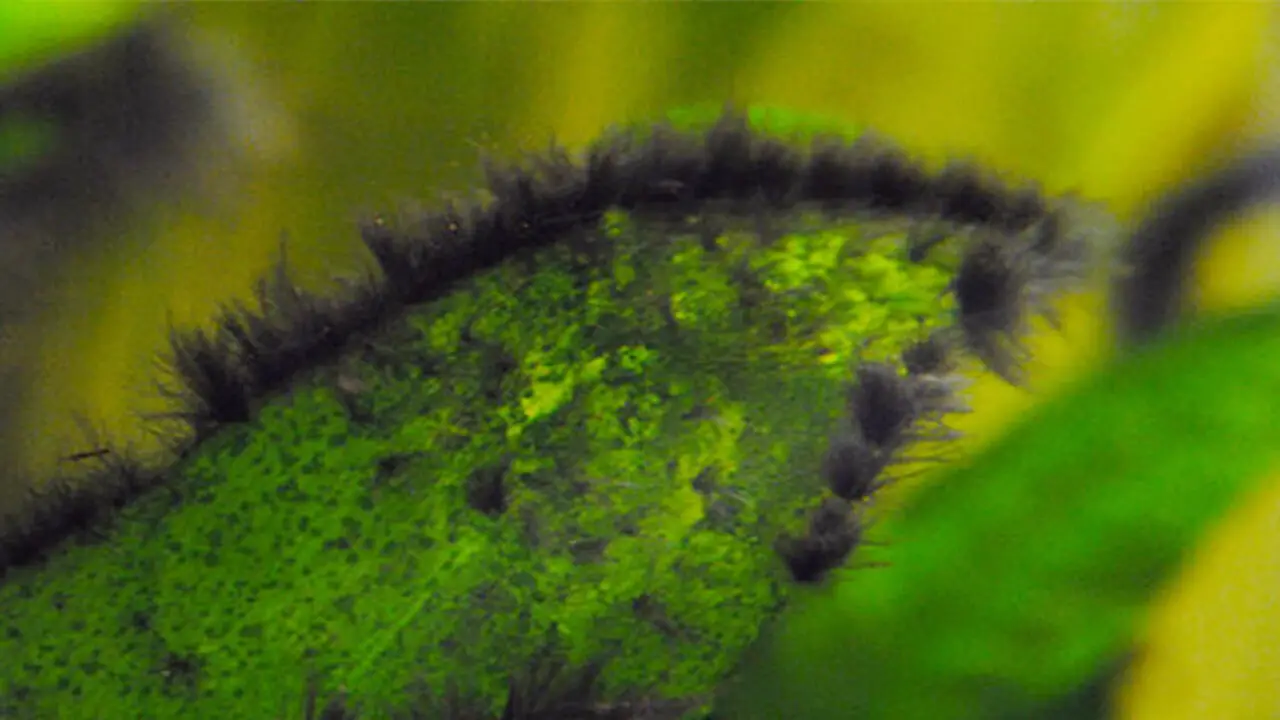
To prevent the growth and spread of black algae in your fish tank, it is important to maintain proper water parameters and quality. Regular water changes and testing water parameters help ensure a healthy aquatic environment. Avoid overfeeding fish or adding too many fish to the aquarium, as excess fish waste can contribute to algae growth. Reducing lighting intensity and duration can also discourage black algae, as it thrives in high-light conditions.
Cleaning aquarium surfaces regularly and maintaining good water flow prevents stagnant areas where black algae can take hold. Introducing algae-eating fish or invertebrates to the aquarium can also help control black algae by consuming them as their food source. These prevention strategies effectively keep black algae at bay and maintain a vibrant and flourishing fish tank.
Maintaining Optimal Water Quality
Maintaining optimal water quality is crucial for preventing the growth of black algae in your aquarium. Understanding the causes of black algae is the first step in effective prevention. To maintain optimal water quality, following a few essential tips is important. Regular aquarium maintenance, such as cleaning the fish tank and gravel, helps remove excess nutrients like nitrates and fish waste that can promote the growth of black algae.
Taking care of live plants in the aquarium is also essential since healthy plants compete with black algae for nutrients and light. Proper lighting is key, as too much light can encourage black algae growth. Monitoring water parameters, such as pH and ammonia levels, is crucial to address any issues immediately. Using tap water treated with reverse osmosis or a de-chlorinator helps ensure the absence of contaminants that can contribute to black algae growth.
By following these best practices, you can maintain optimal water quality and prevent the growth of black algae in your aquarium. Remember, regular monitoring and immediate action are vital to keeping your aquarium healthy and free from the menace of black algae.
Ensuring Healthy Plant Growth
To ensure healthy plant growth in your aquarium, it is important to understand the causes of black algae. Excess nutrients, low light levels, and poor water conditions can contribute to the growth of black algae. To prevent its occurrence, maintaining proper water chemistry is crucial. Avoid overfeeding your fish and ensure good filtration and water circulation.
Regular cleaning and maintenance, such as water changes and cleaning of aquarium surfaces, also help prevent and control black algae growth. Additionally, introducing algae-eating fish or snails can be beneficial. Manual removal with a brush or scraper and chemical treatments can help control black algae if necessary. Balancing plant growth is essential, as healthy plants will compete for nutrients and reduce the growth of black algae.
Importance Of Stable CO2 Levels
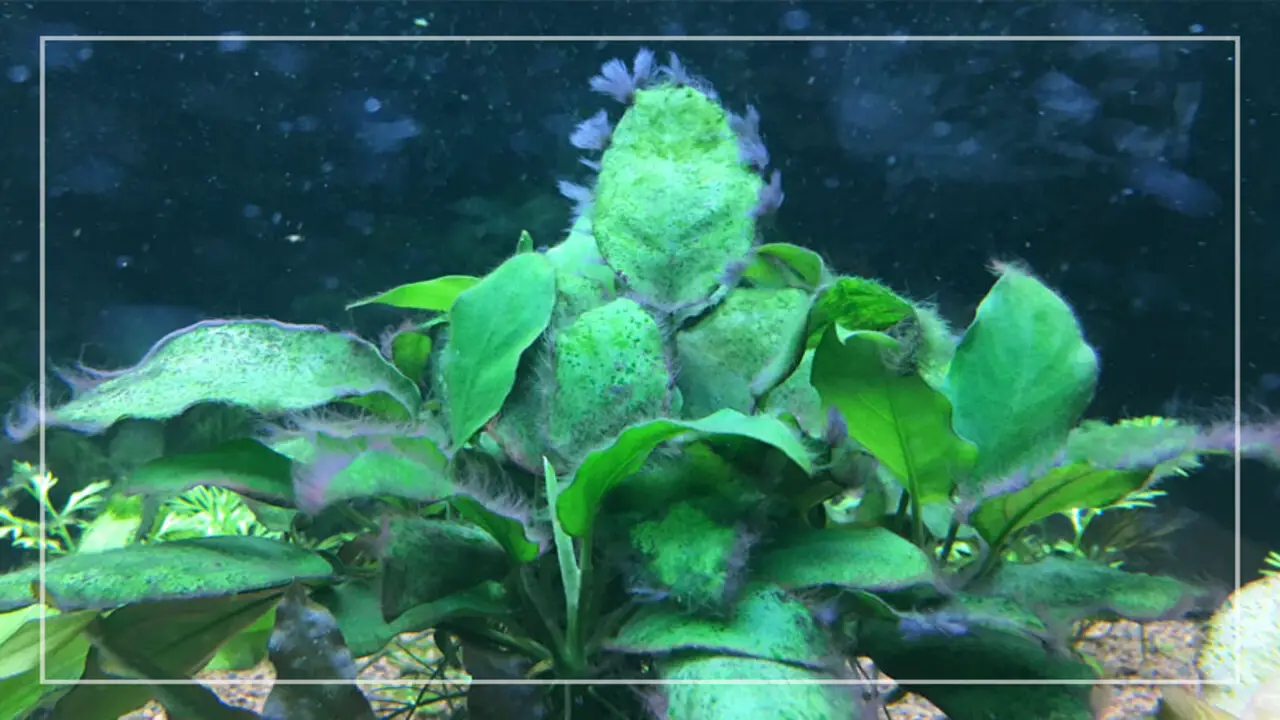
Maintaining stable CO2 levels is crucial in preventing the growth of black algae in aquariums. Fluctuations in CO2 concentration can have detrimental effects on the overall health of the aquarium ecosystem. Excessive CO2 levels can create favourable conditions for the growth of black algae, leading to their rapid proliferation and takeover of the tank. On the other hand, low CO2 levels can result in poor plant growth, leaving the aquarium susceptible to other issues.
Regularly testing and monitoring CO2 levels ensures a healthy aquarium environment. This allows for timely adjustments and interventions to maintain optimal CO2 concentrations. Proper CO2 injection methods, such as using a CO2 diffuser or a CO2 reactor, can help regulate CO2 levels effectively. By carefully managing CO2 input, aquarists can prevent black algae growth and promote a thriving aquatic environment.
Addressing the root cause of black algae includes maintaining stable CO2 levels and addressing other contributing factors in the aquarium. This comprehensive approach ensures that the aquarium remains free from the clutches of black algae and provides a suitable habitat for fish, live plants, and other aquatic organisms.
Conclusion
Dealing with black algae in your aquarium requires a comprehensive approach that includes identifying the causes of algae growth, implementing effective removal techniques, and taking preventive measures to ensure it doesn’t return. To successfully combat black algae in your aquarium, you should physically remove the algae, use treatments like hydrogen peroxide or heat, and consider incorporating algae eaters into your tank.
In addition to these measures, maintaining water quality, regulating light and nutrient levels, and understanding the impact of black algae on your fish are vital steps to take. It is important to note that black algae can be challenging to eradicate completely from an aquarium. Therefore, continuous effort is required to keep it under control. We hope you now understand black algae in aquarium.
Frequently Asked Questions
Why Is My Fish Tank Growing Black Algae?
Poor water conditions, such as excessive light and nutrient levels, can cause black algae growth in fish tanks. Overfeeding and inadequate filtration also contribute to this problem. Regular cleaning, maintaining proper nutrient levels, and using an aquarium-safe algaecide or manual removal can help eliminate black algae.
How Do I Get Rid Of Black Algae In My Aquarium?
Eliminating black algae in your aquarium can be challenging, but effective methods exist. Start by scrubbing the affected areas with a toothbrush or sponge. Consider adding algae-eating fish or snails to help control the growth. Reducing light and nutrient levels in the tank can also prevent black algae from thriving.
Are Black Algae Harmful In Aquariums?
Black algae, also known as BBA, is not harmful to fish in an aquarium. However, it can harm live plants and make the aquarium look unsightly. Poor water quality, low CO2 levels, and inadequate lighting contribute to its growth. Regular maintenance and cleaning can prevent black algae from taking hold.
What Causes Black Algae On Aquarium Plants?
Black algae, also known as blue-green algae, thrive in aquariums due to several factors. Excessive light and nutrient levels in the water contribute to its growth. Poor water circulation and low oxygen levels also create a favourable environment for black algae. Regular maintenance and cleaning of the aquarium can help prevent its appearance.
What Causes Black Beard Algae To Appear In Fish Tanks?
Black Beard Algae, or BBA, thrives in aquariums when there’s an excess of nutrients. Factors like inadequate CO2 levels, poor water circulation, and neglected cleaning and maintenance can contribute to its growth. Overfeeding fish or imbalanced nutrient dosing can also promote BBA. To prevent it, regularly change the water, use proper lighting, and encourage healthy plant growth.

Aquarium passion is all about connecting with the aquatic life and providing education to the public on the importance of these creatures. We showcase a wide variety of marine life through our exhibits as well as working with schools to provide unique learning opportunities for students of all ages.


